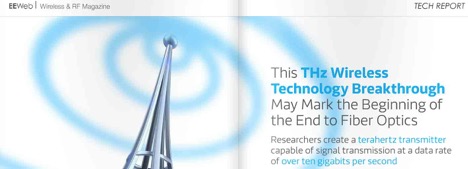Foreign Research on Spectrum Frontiers That FCC and NTIA Block Access To
19 04, 16 22:44 Filed in: mmW | NTIA Reform

This week Wireless & RF magazine published the above article on terahertz (THz) technology R&D in Japan. While we do not necessarily believe it is now time to sell your Corning stock because fiber optic telecom is doomed, this clearly demonstrates continuing foreign interest in technology that FCC is at best apathetic about and which NTIA has allowed certain IRAC members to discourage.
While the major regulatees who routinely show up on the FCC's 8th Floor have little interest in these frequencies, these same corporations and trade association also showed little interest in Docket 81-413 that ultimately spawned Wi-Fi and Bluetooth and Docket 94-124 that stimulated the R&D that showed the surprising result that mmWave/"spectrum frontier" mobile systems were practical. Thus FCC's mainstream spectrum regulatees can sometimes be myopic and sometimes have "crystal ball" problems.
Lest you think that this article about 275+ GHz technology in Japan is isolated, here is a quote from an ETSI report last year:
“With respect to the aforementioned, the mission of ETSI ISG mWT is to promote the use of millimetre wave spectrum from 50 GHz up to 300 GHz for present and future critical transmission applications and use cases. Moreover, ETSI ISG mWT will focus on enhancing the confidence of all stakeholders and the general public in the use of millimetre wave technologies.”
Here are several other article on foreign R&D above FCC present 95 GHz service rule limit and 275 GHz allocation limit:
- Japanese 120 GHz system used at Beijing Olympics
- Japanese 72-100 GHz components
- Japanese 300 GHz receiver — Note that this article indicates that "A portion of these research results were obtained through 'R&D Program on Multi-tens Gigabit Wireless Communication Technology at Subterahertz Frequencies,' a research program commissioned by Japan's Ministry of Internal Affairs and Communications as part of its 'Research and Development Project for Expansion of Radio Spectrum Resources.' " This confirms direct involvement of the Japanese regulator as part of its "industrial policy" program.
- German 237 GHz outdoor experiment - Note that the authors of this experiment have never revealed the exact upper and lower frequency limits of their transmissions and it is likely that it intruded into a passive allocation. Certain IRAC members routinely try to block such experiments regardless of whether they actually impact passive spectrum use and NTIA has not been assertive in overview of such actions.
FCC is moving ahead on Docket 14-177 on "spectrum frontier" mobile use in 28-71 GHz and that is not an issue here. The problem is that FCC has turned its "blind eye" to all other "spectrum frontier" issues while our foreign competitors are marching full speed ahead.
It gets worse! Google "terahertz spectroscopy" and you will see that there are US made products now being sold above 95 GHz for noncommunications use. A careful parsing of §302a and §2.803 of the FCC Rules reveals that the sale of such equipment is presently legal, however the use of such equipment appears to be a violation of §301 since there are no licensed or unlicensed service rules at these frequencies. The manufacturers of such equipment presently have little concern since EB is easily distracted by other mood swings and is laying off much of its field staff. But sooner or later that will need capital access and will discover what "due diligence" means! Denying such firms capital access will not help US competitiveness. FCC outreach to them will! Do you have to presently be a multibillion dollar industry to get FCC attention? We certainly can recall when Wi-Fi was a tiny industry.
Isn't it time for FCC to pay some attention to upper spectrum especially since 275+GHz allocations are on the WRC-19 agenda?
blog comments powered by Disqus



![Validate my RSS feed [Valid RSS]](valid-rss-rogers.png)

